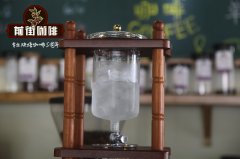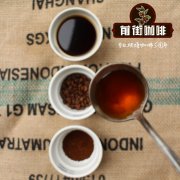What is the growing environment of coffee beans in East Timor? How many kinds of coffee are there in East Timor?

Professional coffee knowledge exchange more coffee bean information please follow the coffee workshop (Wechat official account cafe_style)
What is the growing environment of coffee beans in East Timor? How many kinds of coffee are there in East Timor?
In 1994, after years of conflict, the coffee industry in East Timor began to emerge. With the help of NCBA and USAID, coffee farmers formed a cooperative Cooperativa Caf é coffee. The island, about 400 miles off the northern coast of Australia, was still part of Indonesia at the time, a few years before it declared its independence in 2002.
To stimulate economic growth, Sam Filiaci, a coffee supplier in East Timor at the time, was sent to send hundreds of faxes to potential buyers. Filiaci said that many people were afraid to travel there during that time. However, Olson was one of the first people to respond to his investigation.
Knowing that Indonesia has provided a lot of coffee, from Sulawesi to Sumatra, Olson says it makes sense to go beyond traditional sources. Nonetheless, it is still a dangerous move. He expects East Timor, also known as East Timor, to be relatively underdeveloped when he visits. But he didn't know how underdeveloped it would become.
"the road is bad. The house is very thin. People have nothing. This is not to say that you do not see smiley faces and so on. But Olson says everything you can imagine is troubled politically, economically and socially.
During his first visit, Filiaci had only about half a container of coffee available for sale. That's about 14000 pounds or 120 bags of green coffee, which is not enough, especially by today's standards.
Since its modest start in 1994, Starbucks has continued to purchase coffee from East Timor. Filiaci is still our exclusive supplier, and he now provides us with a lot of Indonesian coffee. Today, coffee plays a vital role in the national economy, and we buy most washed Arabica coffee.
The quality of coffee continues to improve, and we highlight East Timor coffee through special platforms, such as Starbucks Reserve ®East Timor Peaberry and Starbucks East Timor Tatamailau, part of our single original product line.
East Timor, often referred to as East Timor, is an island country that straddles the Indian and Pacific oceans. In 2002, 1.2 million people became only official sovereign states. For countries of this size, Starbucks' global brand promotion capabilities will give a huge boost to the economy, tourism and global market awareness.
Mount Rameleau, which is 9721 feet (2963 meters) above sea level, is the highest peak on the island of Timor and has a rich and fertile ecology. In the native language of Dayton, it is called Tata Mailau, which literally means: everyone's grandfather. A 2013 study by the United Nations Development Programme noted that recent deforestation has rapidly become a growing problem in Timor-Leste. This is a problem that sustainable procurement and the expansion of the coffee industry may help alleviate. The Natural Resources Defense Council said that "agroforestry systems, including those involving coffee, have the potential to improve the economic and ecological stability of a country."
Starbucks'21-year partner, Andrew Linneman (Andrew Linneman), is enthusiastic about the new Mount Rameleau coffee, serving consumers and the people of Timor-Leste. He described coffee from around Rameleau Mountain as "very different" coffee with "brighter flavor characteristics", which is not typical of Asian coffee production. Mr. Linaman, who first began buying coffee from East Timor in 1996, is pleased that Starbucks is now able to showcase a single coffee in the region. As vice president of global coffee quality and participation at Starbucks, he said the new Mount Ramello Coffee "is an important recognition of the work done by the East Timorese government and our farmers in improving infrastructure and supply chains."
As a 2013 report noted, "46 per cent of East Timorese households rely entirely on coffee for their income." A 44-page study of improving farmers' lots in East Timor by the Swedish Institute of Industrial Economics found in 2012 that infrastructure, outdated factories and other technical problems hampered the coffee industry in Timor-Leste. It cites other studies by the World Bank that gross profit margins could increase nearly fourfold through investment and renewal, and the return per International Labour Day could increase by more than 50 per cent. The report of the Institute of Industrial Economics, released two years before Starbucks launched single-origin coffee, concluded that Starbucks' existence and its influence on the promotion of coffee in the country
Coffee is the main cash crop in Timor-Leste and the country's main export, with some 67000 households growing coffee in 2009 and so far exports are mainly aimed at high-quality niches in foreign markets. Starbucks' decision to sell coffee from East Timor has greatly enhanced the reputation of the product and opened up a huge potential market.
Mr. Linneman said that about 22000 farmers in the cooperative supply Starbucks from East Timor. He is looking forward to the new Mount Rameleau specialty coffee to "enhance our customer experience". For the same reason, he stressed the importance of coffee and farmers' rights (CAFE) to practice Starbucks hiring coffee in all 28 countries. These practices include environmental and social programmes. For example, Starbucks helps to cover these costs by providing 20 mobile medical clinics and nine fixed-location clinics for farmers working with Starbucks partners in East Timor. Mr. Linneman stressed, "our success is closely related to the success of our farmers, who want to provide farmers with stability so that we can reliably produce our products for consumers and provide reliable livelihoods for our farmers.
Many communities in East Timor are beset by what they call a "hunger season"-four months of famine left crops dry last year and the next harvest is not ready.
The high child mortality rate caused by malnutrition and poverty is the worst in Asia and is often unsalvaged by farmers during bumper harvests.
The World Bank's private sector lists East Timor as one of the most difficult places in the world to do business, but a number of non-governmental organizations are working to rebuild the small country's self-sufficient agricultural base and business practices.
For agriculture, it takes a decade to rebuild industry for villages with paralysed hunger and poverty burdens; non-governmental organizations such as Empreza Di'ak are improving facilities and livelihoods and carrying out different projects in a country with large food imports.
Other organizations such as Life Seeds are working to identify high-yielding crop varieties that best suit the country's climate.
Through the introduction of reliable seeds, they hope to improve agricultural livelihoods and increase yields in Timor-Leste, but efforts to improve food security and seed distribution in this major agricultural society remain controversial.
Some locals skeptically accept modern agricultural methods and industrialization, saying that traditional organic methods and crops are better because they are part of cultural identity.
Timor coffee plant varieties:
The interspecific hybrid robusta (fruit coffee variety Robusta) and the Hybrido Timor coffee plant variety of small seed coffee were first discovered in Timor Indonesia in 1940.
Timorese coffee plants have been planted because of their strong resistance to coffee leaf rust, a disease that afflicts most coffee plant species.
Qianjie recommended cooking:
Filter cup: KONO filter cup
Water temperature: 88 degrees
Degree of grinding: small Fuji degree of grinding 4
Cooking method: the ratio of water to flour is 1:14, 17g powder, 25g water for the first time, steaming for 30s, and 238g water for the second time. The extraction time is about 2:30 seconds.
Analysis: there are not many ribs at the bottom of the Kono cup, and the filter paper clings to the filter cup to achieve the purpose of limiting air flow, which can make water and coffee powder have longer contact soaking time in the filter cup and ensure the extraction time and extraction rate of rough grinding. In this way, the coffee powder can be fully extracted, enhance the mellow taste and make the taste more concentrated.
Important Notice :
前街咖啡 FrontStreet Coffee has moved to new addredd:
FrontStreet Coffee Address: 315,Donghua East Road,GuangZhou
Tel:020 38364473
- Prev

FAQ certification-the flavor characteristics and treatment of AA coffee beans in Dogilimanjaro, Tanzania? Tan
Professional coffee knowledge exchange more coffee bean information please follow the coffee workshop (Wechat official account cafe_style) FAQ certification-Tanzania multi-door Kilimanjaro AA coffee beans flavor characteristics and treatment? How to process raw beans in Tanzania? Kilimanjaro coffee is grown on the volcanic slope, the highest peak in northeastern Tanzania, the African continent, showing a distinct flavor.
- Next

What is the variety of East Timor coffee beans-Tim Timor? What is the flavor and taste of East Timor coffee?
Professional coffee knowledge exchange more coffee bean information please follow the coffee workshop (Wechat official account cafe_style) East Timor coffee beans-Tim Timor what kind of coffee? What's the flavor and taste of East Timorese coffee? How to brew? Hibrido de Timor (or Timor hybrid) coffee is Coffea arabica (Arabica coffee) and C. canephora (Luo)
Related
- Detailed explanation of Jadeite planting Land in Panamanian Jadeite Manor introduction to the grading system of Jadeite competitive bidding, Red bid, Green bid and Rose Summer
- Story of Coffee planting in Brenka region of Costa Rica Stonehenge Manor anaerobic heavy honey treatment of flavor mouth
- What's on the barrel of Blue Mountain Coffee beans?
- Can American coffee also pull flowers? How to use hot American style to pull out a good-looking pattern?
- Can you make a cold extract with coffee beans? What is the right proportion for cold-extracted coffee formula?
- Indonesian PWN Gold Mandrine Coffee Origin Features Flavor How to Chong? Mandolin coffee is American.
- A brief introduction to the flavor characteristics of Brazilian yellow bourbon coffee beans
- What is the effect of different water quality on the flavor of cold-extracted coffee? What kind of water is best for brewing coffee?
- Why do you think of Rose Summer whenever you mention Panamanian coffee?
- Introduction to the characteristics of authentic blue mountain coffee bean producing areas? What is the CIB Coffee Authority in Jamaica?

